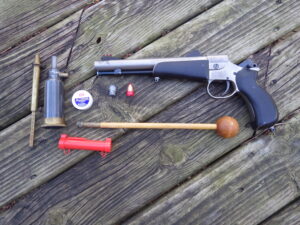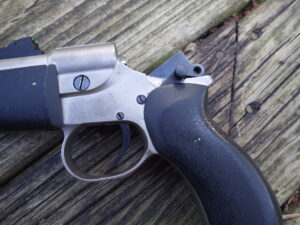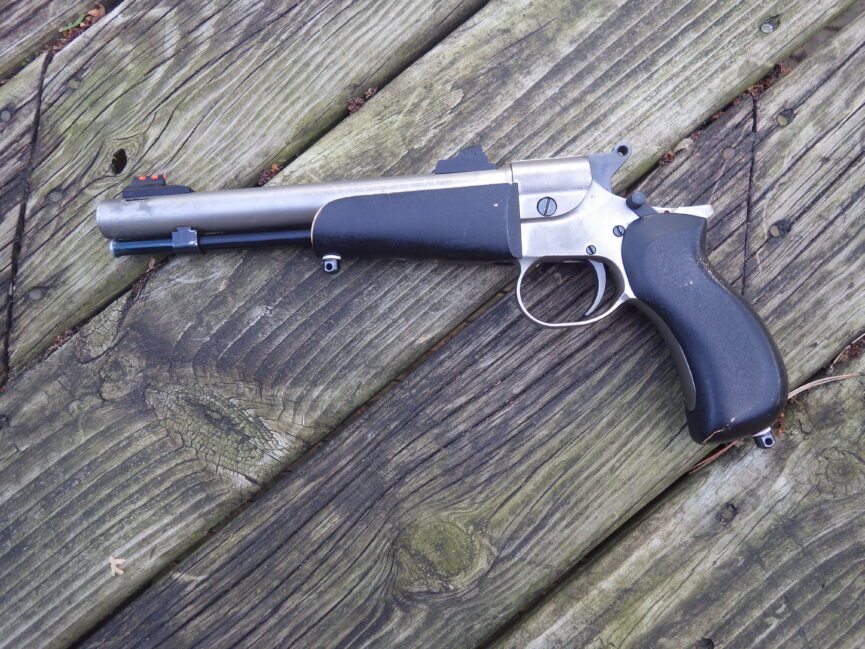
Author’s depiction of the “kit & caboodle”
During the 1790’s, British officers and other gentlemen associated with the East India Company in India were introduced to big game hunting from the backs of elephants, riding in a basket-like platform known as a “howdah”. A key animal hunted was the tiger, which is a tad bigger than lions, and tigers are very fast and agile, and were well known for jumping and clawing their way up an elephant to reach a hunter riding in the howdah. Having something weighing around 600 pounds which is equipped with meat grinding sharp teeth and claws, can be a bit unsettling, especially if a single-shot musket had just been fired, and isn’t much better than a club in a futile attempt to ward off the attack.
It was quickly decided a handy “backup” pistol offering a potent punch was the perfect remedy for handling an up close and very personal encounter, and these were placed in holsters on the howdah, hence the name. The first were single-shot flintlock military “horse-pistols” with .71 caliber smoothbores, which was the same caliber as the military-issue “Brown Bess” musket. It was soon realized having two barrels was better than one, and British arms manufacturers were quick to meet the need. Percussion models would soon follow, and when the British military switched to centerfire brass cartridges used in breechloading rifles, the howdah pistols followed suit.
The first cartridge-using howdah pistols were military single-shot rifles in 577 Nider or 577/450 Martini-Henry calibers (both using 485 grain lead bullets backed by 85 grains of black powder), which were cutdown to pistol form. It would be convenient if the backup pistol used the same ammunition as the rifle. Again, British arms manufacturers met the growing need, and began making howdah pistols, usually with 2 or 4 barrels in a wide variety of calibers. A favorite was the “Lancaster Howdah Pistol” and the fictional big game hunter Charles Remington in the movie “The Ghost and the Darkness”, carried a double-barreled Lancaster as a backup gun, and it also featured a spring-loaded blade, if needed.
Howdah pistols were also popular with British officers during battles, because they were quick to load and had a lot more man-stopping punch than the revolvers of the time. Some would even see use in World War I.
I began using muzzleloaders for deer hunting during the early 1970’s, and developed a fondness for the .54 caliber, which I retain to this day. Using a .530 patched roundball backed by 100 grains of 2f black powder does an admirable job on whitetails. When conical bullets and sabots were allowed, I gave the heavyweight conical bullets a try, with my favorite being the T/C 435 grain Maxi-Hunter, which is a real “thumper”! I didn’t go the sabot route, because I don’t wish to downsize what the .54 caliber is designed to do, which is to make a big hole.
When using handguns for deer hunting in southern Michigan was finally allowed, I jumped on the bandwagon right away, and it has remained a passion of mine ever since. About 30 years ago, I stopped by the “Ye Olde Black Powder Shoppe” in Auburn, owned by Bill Stellhorn and his wife Gail. This was my favorite go-to place for everything black powder, and when I arrived, Shellhorn showed me a newly developed .54 caliber muzzleloading pistol, which had been designed by his friend, Jay Brenneman, who was an owner of Traditions Firearms.
Well, folks, up to that time I hadn’t been much interested in the new-fangled “inline” muzzleloaders which were beginning to get a strong foothold for deer hunting. However, this pistol piqued my interest, and the more I handled it, the more I liked it. Called the Traditions BuckHunter inline pistol, its profile reminded me of my T/C Contender pistol, including a hand-filling pistol grip, and yep, I got one. I would be able to combine my love of muzzleloaders and handguns for deer hunting!
Brenneman sure knew what he was doing when he designed this unique piece which has a bird’s head grip, and an oversized trigger guard which is egg-shaped, so it doesn’t connect with a middle finger during heavy recoil and allows a gloved index finger easy access to the large trigger. The hammer can be “cocked and locked” and completely covers the # 11 percussion cap upon firing, and there is hole in the top for venting any gas or debris away from the shooter’s face.
My piece has a nickel-plated 9-inch barrel and receiver, and the pistol grip and forearm are hardwood, which is covered with texturized black paint, allowing for a good grip. The paperwork with it said a maximum powder charge was 80 grains of 2f black powder or Pyrodex and I would eventually settle on 70 grains of 3f black powder. This gun with its 1:20 rifling can handle either roundballs or conicals and it is a “plinker” when using 230 grain roundballs. However, it becomes a tad “boisterous” when it is stoked with a .54 caliber T/C 435 grain maxi-hunter and becomes a thumper with strong ties to a howdah pistol!

note the hammer accessory allowing for a scope mount
The only problem with this load is the recoil caused the ramrod under the barrel to depart on occasion, and I had my friend Ken Kelly of Mag-Na-Port port the barrel to tame the recoil, which resolved the issue. Although I dearly love the performance of the T/C maxi-hunter rounds, they are interesting to load for a follow-up shot in the field, usually requiring a handy tree trunk to brace the pistol butt on to start things down the muzzle. This was all resolved when the easy to load PowerBelt bullets came into the picture and the .54 caliber 348 grain version is a bread-and-butter combination with my BuckHunter and its preferred powder charge, which still retains the howdah pistol tradition.
The original sights on the pistol were a bit course, and I immediately topped it with a Weaver Qwik Point red dot sight which gave the entire package a “Buck Rogers” appeal. However, the Qwik Point eventually gave up the ghost due to recoil and I then mounted on a low power pistol-scope, which worked great until I realized the front lens was a bit too close to the ports near the muzzle, and I felt that escaping smoke and sparks might do it damage. I now have low profile Williams “express” sights which are fiberoptic and quick and easy to see in lowlight conditions.
The BuckHunter was my first inline experience. I’ve yet to experience a misfire when using CCI #11 magnum percussion caps, and the ignition is instantaneous. Although I have a shoulder holster which works with this pistol, I equipped it with sling swivels early on and prefer to cart it around that way. It is a handy and compact hunting piece which packs a punch, the howdah pistol way.
Nope, folks, whitetails aren’t tigers by any means, but they are tough and tenacious in their own way and are sometimes hard to put down for keeps. I’ve found an extra bit of punch never hurts to seal the deal.

